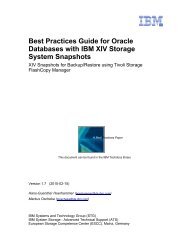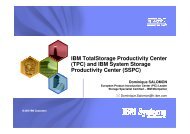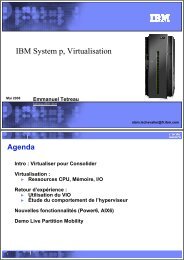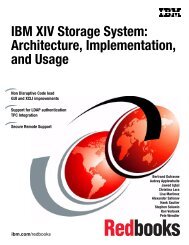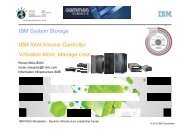IBM XIV Storage System Copy Services and Migration
IBM XIV Storage System: Copy Services and Migration - Common ...
IBM XIV Storage System: Copy Services and Migration - Common ...
- No tags were found...
You also want an ePaper? Increase the reach of your titles
YUMPU automatically turns print PDFs into web optimized ePapers that Google loves.
The mirror has the following characteristics:► When a mirror is created, it is always initially in inactive mode.► A Mirror can only be deleted when its is in inactive mode.► Transitions between the two states can only be performed from the <strong>XIV</strong> with the master.► In a DR situation, a role change changes the slave peers (at the secondary system) to amaster role (so that production can resume at the secondary). When the primary site isrecovered, <strong>and</strong> before the link is resumed, the master must be changed to a slave(change_role).DeletionWhen a mirror pair (volume or consistency group) is inactive, the mirror relationship can bedeleted. When a mirror relationship has been deleted, the <strong>XIV</strong> forgets everything about therelation. If you want to set up the mirror again, the <strong>XIV</strong> must do an initial copy again from thesource to the target.Note that when the mirror is deleted, the slave volume becomes a normal volume again, butthe volume is locked, which means that it is write protected. To enable writing to the volumego to the Volumes list panel. Right-click the volume <strong>and</strong> select Unlock.The slave volume must also be formatted before it can be part of a new mirror. Formattingalso requires that all snapshots of that volume be deleted.5.2 Disaster recoveryThere are two broad categories of disaster, one that destroys the primary (local) site or thedata there <strong>and</strong> one that makes the primary site or the data there unavailable but that leavesthe data intact. However, within these broad categories there are a number of situations thatmay exist. Some of these <strong>and</strong> the recovery procedures are considered below:►►►A disaster that makes the <strong>XIV</strong> at the primary site unavailable but the site itself <strong>and</strong> theservers there are still availableIn this scenario the volumes/CG on the <strong>XIV</strong> at the secondary site can be switched tomaster volumes/CG, servers at the primary site can be redirected to the <strong>XIV</strong> at thesecondary site, <strong>and</strong> normal operations can start again. When the <strong>XIV</strong> at the primary site isrecovered the data can be mirrored from the secondary site back to the primary site.When it is synchronized the peer roles can be switched back to the master at the primarysite <strong>and</strong> the slave at the secondary site <strong>and</strong> the servers redirected back to the local site.A disaster that makes the entire primary site <strong>and</strong> data unavailableIn this scenario, the st<strong>and</strong>by (inactive) servers at the secondary site are activated <strong>and</strong>attached to the secondary <strong>XIV</strong> to continue normal operations. This requires changing therole of the slave peers to become master peers.After the primary site is recovered, the data at the secondary site can be mirrored back tothe primary site to become synchronized once again. If desired, a planned site switch canthen take place to resume production activities at the primary site. See 5.3, “Role reversal”on page 134, for details related to this process.A disaster that breaks all links between the two sites but both site remain runningIn this scenario the primary site continues to operate as normal. When the links arereestablished the data at the primary site can be resynchronized with the secondary site.See 5.4, “Resynchronization after link failure” on page 136, for more details.Chapter 5. Synchronous Remote Mirroring 133



